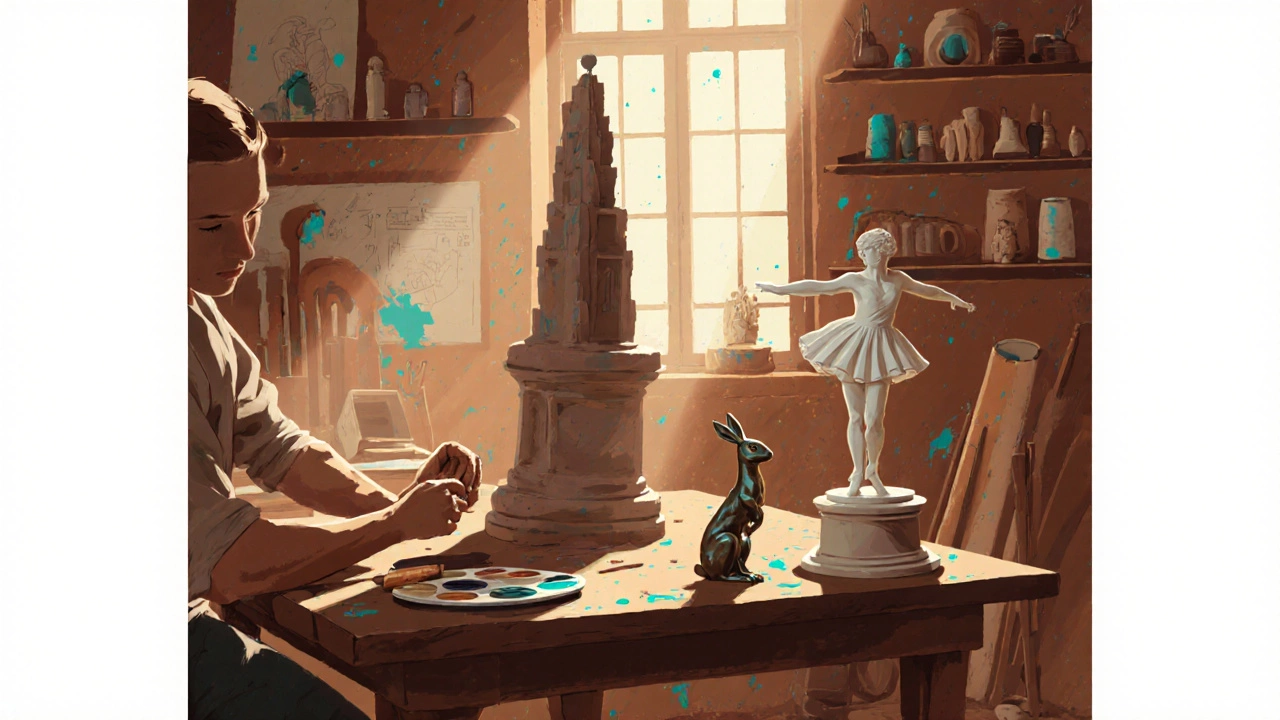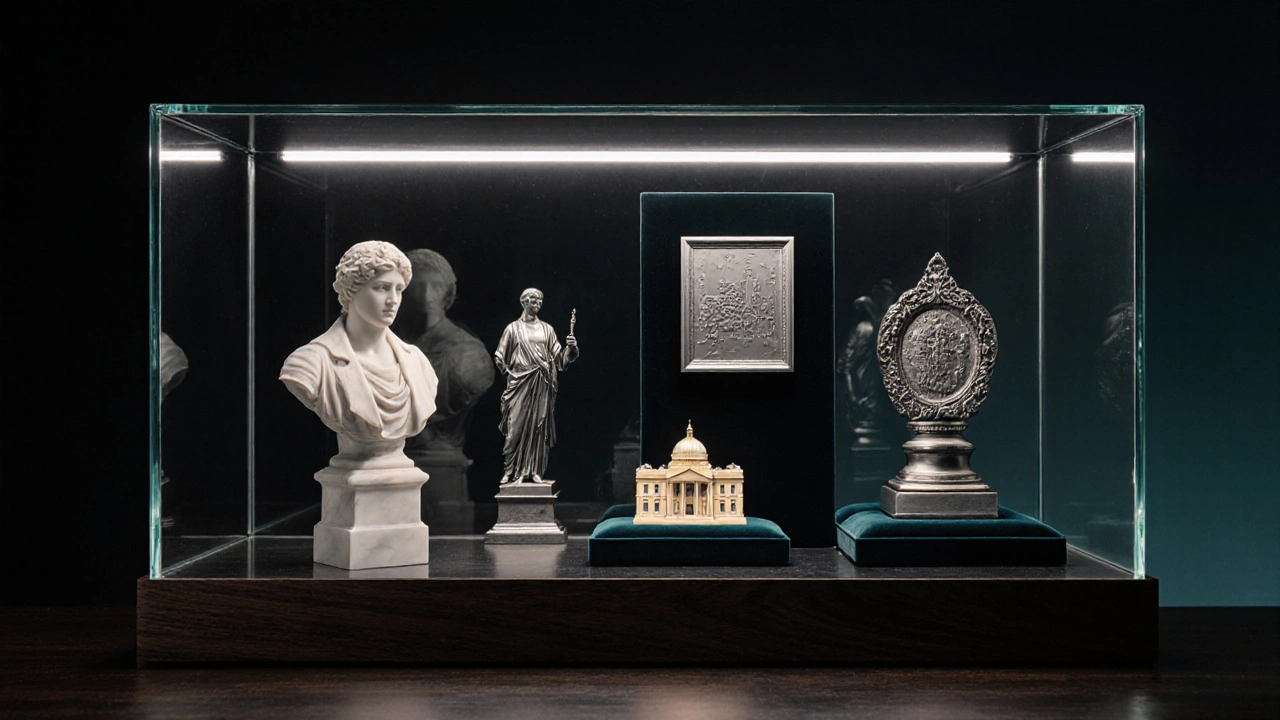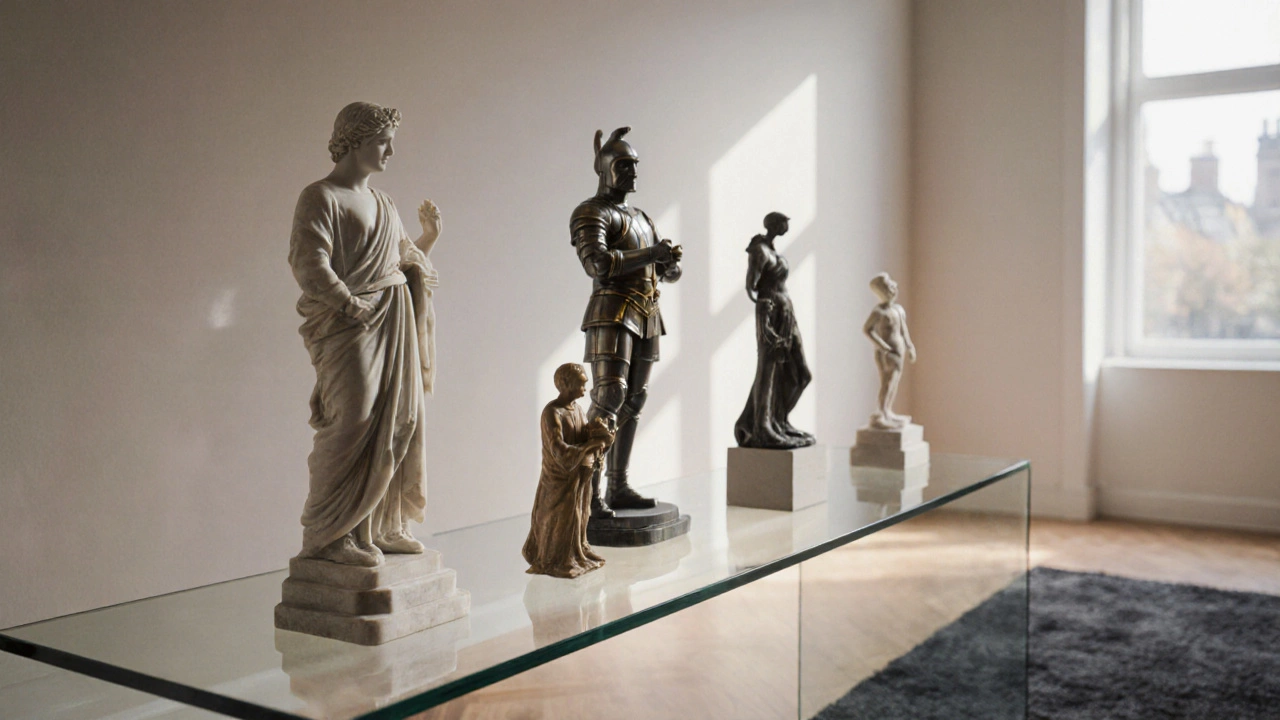Small Sculpture Identifier
Identify Your Small Sculpture
Enter the characteristics of your sculpture to find the most appropriate category name.
Ever walked into a gallery and wondered what to call those tiny, detailed three‑dimensional pieces? Those objects fall under the umbrella of small sculptures, but the art world uses a handful of specific terms to describe size, purpose, and style. Knowing the right word not only helps you talk intelligently with curators, but also guides artists when they label their work for sales or exhibitions.
Defining Small Sculptures
Small sculptures are three‑dimensional artworks that typically measure under 30cm (12in) in their greatest dimension. They are crafted from the same range of materials as larger pieces-bronze, stone, wood, clay, or modern polymers-but their reduced scale demands a higher level of precision and often serves intimate viewing contexts like collectors’ cabinets, tabletop displays, or museum dioramas.
Artists choose a compact size for several reasons: to explore detailed anatomy without the logistical challenges of moving a massive stone block, to create affordable editions for a broader audience, or to experiment with concepts that lose impact when enlarged.
Miniature
Miniature is a term that emphasizes the reduction of an object to a smaller scale while preserving its original proportions. Miniatures often replicate larger works-think a tiny replica of Michelangelo’s David-so collectors can appreciate the composition without the spatial demands. Common materials include resin, pewter, and ivory, and they frequently serve as study models for architects or as decorative objects in dollhouses.
Because miniatures aim to be faithful copies, they usually retain the texture and finish of the original, whether that’s a polished marble sheen or a rough stone patina.
Figurine
Figurine refers to a small, three‑dimensional representation of a human, animal, or mythical creature, often intended for decorative or symbolic purposes. Unlike miniatures, figurines are not necessarily reduced versions of larger works; they are created specifically for a small format.
Figurines have a rich history in cultures worldwide-from Japanese netsuke to European porcelain figures. Materials range from ceramic and porcelain to metal and polymer clay, and they can be highly stylized or anatomically accurate, depending on the artist’s intent.
Maquette
Maquette is a scale model used by sculptors, architects, and designers to visualize a larger composition before committing to full size. The term originates from the French word for “model” and is a staple in the workflow of monumental public art.
Maquettes are typically crafted in clay, wax, or plaster and can be displayed on a workbench or photographed for presentations. While not always intended for display on their own, many maquettes become collectible items because they reveal the artist’s creative process.
Statuette
Statuette is a small statue, usually portraying a single figure or a simple group scene. The term often implies an object meant for display rather than a preparatory model.
Statuettes have long been used as awards (think Academy Award trophies) or as religious icons in private shrines. Bronze, silver, and gilded wood are classic media, while contemporary artists might experiment with acrylic or recycled materials.

Relief
Relief is a sculptural technique where figures are raised from a flat background. When a relief is small enough to fit on a tabletop or wall niche, it joins the family of small sculptures, though the term emphasizes the method rather than size.
Low (bas‑relief) and high (alto‑relief) variations exist, with materials ranging from carved stone and wood to cast plaster and metal panels. Small reliefs often adorn picture frames, furniture, or architectural models.
Bust
Bust captures a person’s head, shoulders, and upper chest in three dimensions. While busts can be monumental, many are crafted at a reduced scale for private collections, portrait studios, or academic study.
Artists typically work in marble, bronze, or plaster for busts. When rendered at a small size-often under 25cm-they are displayed on pedestals, shelves, or within glass cases, making them a popular choice for commemorating family members or historical figures.
Model
Model is a broad term that encompasses any three‑dimensional representation made for study, demonstration, or sale. In the context of small sculptures, a model usually refers to a reduced version of a larger concept, similar to a maquette, but can also denote a finished decorative piece.
Models may be cast in resin, 3‑D printed in polymer, or hand‑carved from wood. They bridge the gap between conceptual sketches and full‑scale execution, allowing artists to test proportions, lighting, and material behavior.
Quick Comparison of Common Types
| Type | Typical Size | Common Materials | Primary Use | Historical Context |
|---|---|---|---|---|
| Miniature | 1mm - 30cm | Resin, pewter, ivory | Replicas, collector’s items | Renaissance to present |
| Figurine | 5cm - 25cm | Porcelain, metal, polymer clay | Decorative, cultural symbols | Ancient Egypt, Asian netsuke |
| Maquette | 5cm - 50cm | Clay, wax, plaster | Design development | Baroque & modern public art |
| Statuette | 3cm - 20cm | Bronze, silver, wood | Award, personal veneration | Classical to contemporary |
| Relief | 2cm - 30cm (depth) | Stone, metal, plaster | Architectural ornamentation | Greek, Roman, Gothic |
| Bust | 10cm - 25cm | Marble, bronze, plaster | Portraiture, commemoration | Renaissance onward |
| Model | Varies (often <30cm) | Resin, 3‑D printed polymer | Study, prototype, sale | Industrial design, fine art |

Choosing the Right Term for Your Work
When you label a piece, think about three questions: size, intent, and tradition. If the piece is a faithful reduction of a larger statue, “miniature” or “maquette” signals that relationship. If it’s a standalone figure meant for display, “figurine” or “statuette” communicates its decorative nature. A relief that protrudes from a wall panel stays a “relief,” regardless of scale.
Markets also matter. Galleries that specialize in decorative arts prefer “figurine,” while academic institutions might list “maquette” in a catalog of process works. Knowing your audience helps you pick the term that resonates and improves discoverability in online searches.
Caring for Small Sculptures
Because of their size, small sculptures are more vulnerable to handling damage, dust, and environmental fluctuations. Store them on padded trays, avoid direct sunlight to prevent fading of pigments, and maintain a stable humidity range (45‑55%). For metal pieces, occasional polishing with a soft cloth prevents oxidation, while organic materials like wood or bone benefit from occasional dusting with a soft brush.
When displaying, use low‑profile mounts that keep the weight evenly distributed. Glass cases with UV‑filtering glass add protection without obscuring detail. If you’re rotating works for an exhibition, label each piece with its term-e.g., “Figurine: Bronze Hare, 2023”-to educate viewers and reinforce correct nomenclature.
Common Misconceptions
- All tiny sculptures are "miniatures"-false. A tiny portrait bust is a bust, not a miniature.
- "Figurine" implies a low artistic value-untrue; many museum collections feature exquisite porcelain figurines.
- Maquettes are never sold-while many serve as private study pieces, they are also collected and auctioned.
Frequently Asked Questions
What size qualifies a sculpture as "small"?
Generally, anything under 30cm (12in) in its largest dimension is considered a small sculpture. However, museums may set their own thresholds based on exhibition space.
Is a maquette always an unfinished work?
Not necessarily. Many artists finish maquettes with the same detail as a final piece, and collectors often purchase them as standalone artworks.
How do I determine whether to call my piece a figurine or a statuette?
"Figurine" typically refers to a decorative, often mass‑produced object, while "statuette" suggests a more formal, often hand‑crafted work intended for display or award purposes.
Can reliefs be considered small sculptures?
Yes, when a relief’s overall dimensions fit within the small‑scale range, it is grouped with other small sculptures, even though its technique differs from free‑standing forms.
What materials are best for preserving a small sculpture?
Stable materials like bronze, stone, and high‑quality resins age well. Avoid porous materials that can absorb humidity unless sealed. Regular dusting and controlled lighting extend longevity.



